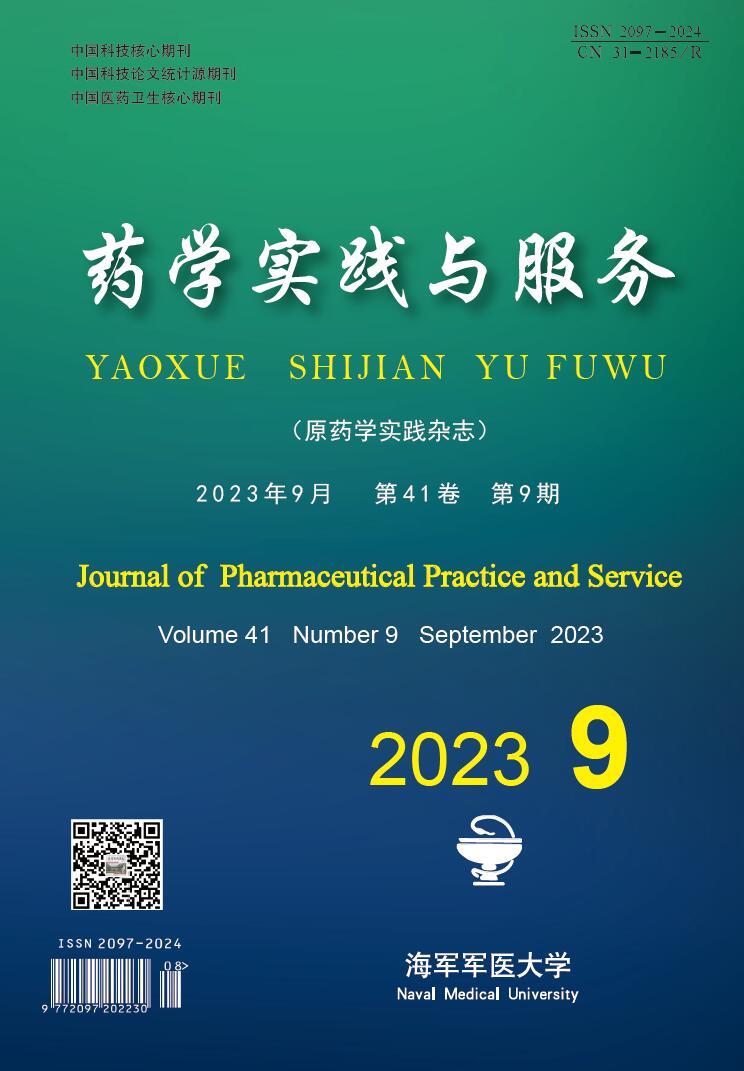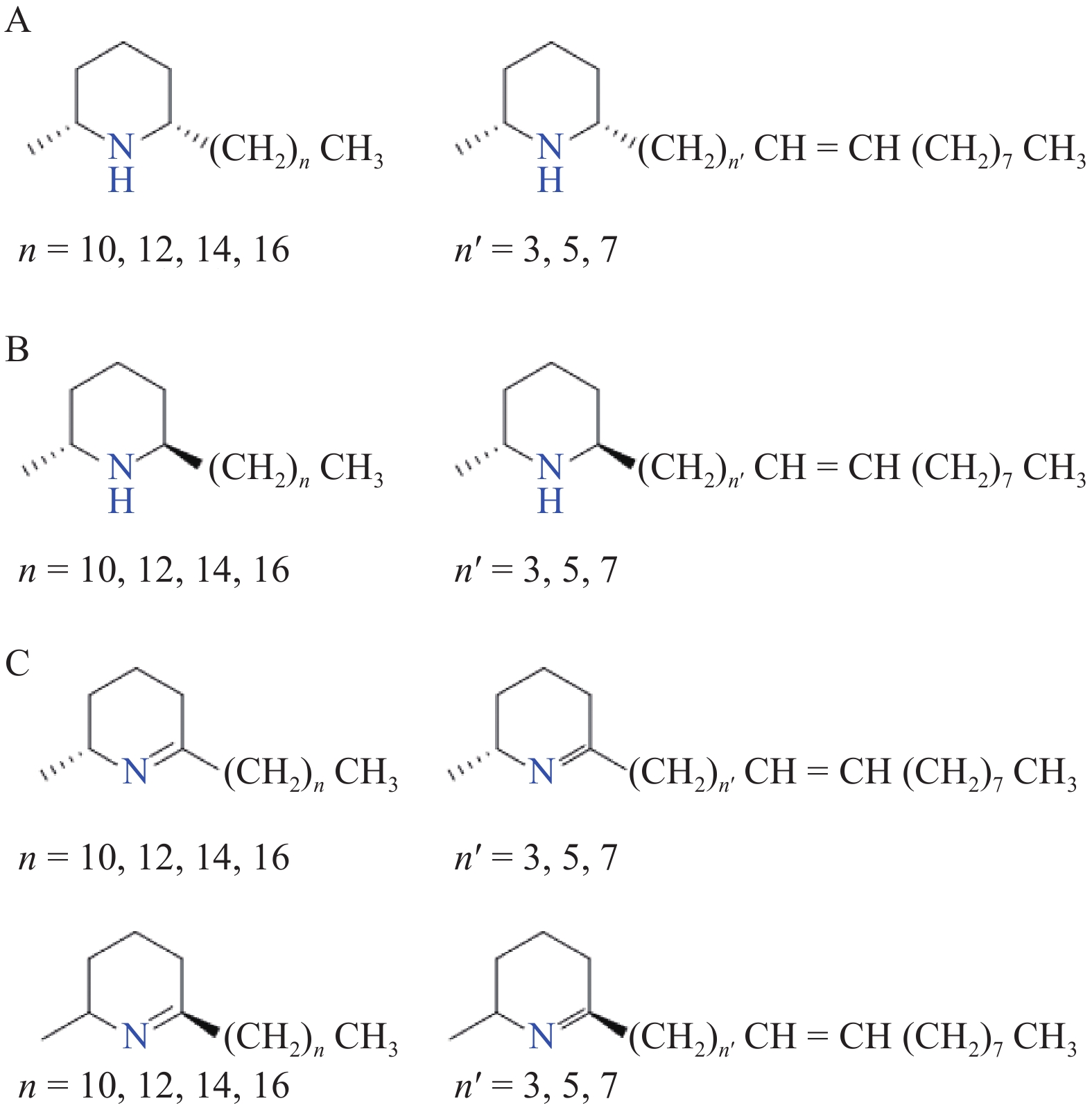-
在我国,红火蚁是一种对农业生产、生态环境、人畜健康和公共安全造成严重危害的入侵性害虫之一。红火蚁通过毒针刺伤人类皮肤,每次将大约0.66 nl毒液注入人的皮肤[1-2]。患者被蛰伤时会立即产生持续剧烈的灼烧感,随后出现瘙痒、疼痛、水泡、丘疹等局部症状,严重者会出现头痛头晕、心悸胸闷、心律失常等全身症状;对毒液过敏的患者则会出现更严重的哮喘、喉头和支气管水肿等全身性过敏反应,甚至出现过敏性休克,危及患者生命[3-5]。红火蚁毒液的主要成分包括水、生物碱和少量的蛋白质[6],本文详细综述了目前对红火蚁毒液中各毒素物质的研究进展以及各组分的作用和功能。
-
生物碱是红火蚁毒液重要的组成成分,其主要成分是2-甲基-6-烷基哌啶生物碱混合物,约占毒液总量的95%[7-8]。这些哌啶生物碱存在立体异构现象,顺式生物碱构型为(2R,6S)(图1A),反式构型为(2R,6R)(图1B),反式生物碱与相应的顺式异构体的比值为87~378:1[8-9]。另外,红火蚁体内还存在一些哌啶环上含双键的△1,6和△1,2-2甲基-6-烷基哌啶类混合物,这些生物碱可能是红火蚁毒素中顺式生物碱和反式生物碱的合成前体[9] (图1C)。Chen L[10]等已人工合成一系列外消旋2-甲基-6-烷基-△1,6-哌啶类化合物,用于红火蚁毒液中天然产物的化学确证和生物活性评价。除了哌啶类生物碱外,红火蚁毒液中还存在少量的吡啶类生物碱。Chen J[11]等采用硅胶柱层析分离法,利用SPME和SPME-GC-MC技术在红火蚁工蚁毒液的生物碱中首次分离和鉴定出6种2-甲基-6烷基(或烯基)吡啶类生物碱,其中4种生物碱也存在于雌性红火蚁体内。最近,Vander Meer [12]等在工蚁毒液中又意外地发现了6-十一烷基吡啶、2-甲基-6-十一烷基吡啶和2-甲基-6-(1)-十一烯基吡啶等3种新的生物碱,在红火蚁毒液研究方面取得了新的进展。
红火蚁毒液中生物碱的含量与红火蚁的种类、大小、年龄、分布地域等因素有关。在同一巢穴中,雌性生殖蚁的生物碱含量相对较高,约83 μg/头,而工蚁体内的生物碱含量则与其个体的大小呈正相关,中龄工蚁体内生物碱含量远高于老龄工蚁和幼龄工蚁[13]。由于被入侵地的环境、生态等影响,不同地区的红火蚁毒液生物碱组分的相对含量也会存在明显差异[14]。
-
红火蚁体内的碱类分泌物能够有效抑制各种病原微生物,使红火蚁免于各种疾病的困扰[15]。但是这些生物碱作用于人体时能够抑制细胞Na+和K+-ATP酶作用,限制线粒体呼吸,在低浓度下即可解除氧化磷酸化,阻断神经肌肉连接,促使肥大细胞释放组胺和血管活性物质,因此患者被蛰伤时局部组织会发生坏死、溶血[5]。红火蚁毒液中的生物碱具有一定的抗菌活性,其中trans-C11、trans-C13、trans-C15对革兰阳性菌抑制作用较强[16]。患者在被红火蚁蜇伤初期一般不会发生细菌感染,但是若处理不及时或者处理不当,则会造成二次感染,形成脓疱[17]。
红火蚁毒液中的生物碱成分在介导寄生性天敌对红火蚁工蚁的吸引力方面起着重要作用,例如寄生性蚤蝇能够利用红火蚁分泌的示警信息素定位工蚁位置[18]。 Chen L等[19] 通过实验证实蚤蝇对毒液生物碱中的cis-C11、cis-C13:1、cis-C13、cis-C15:1、cis-C15、trans-C11、trans-C13:1、△1,6-C15:1 和△1,6-C15存在触角电位(EAG)反应,为红火蚁毒液生物碱作为苍蝇引诱剂的可能作用机制提供了新的见解。
红火蚁蚁后和雌性生殖蚁体内的生物碱还具有特殊的信息交流作用。这些毒液能够用于蚂蚁种群的建立,并且反映蚁后的发育程度以及鉴别蚁后的基因型[20]。
-
红火蚁毒液中的蛋白质含量只占毒液总量的5%,但是其抗原性强,毫微克即可引起致敏并诱发过敏反应。Hoffman等[21] 从红火蚁毒液中分离提纯出4种均一性蛋白:Soli Ⅰ(Solenopsis invicta Ⅰ)、Soli Ⅱ、Soli Ⅲ和Soli Ⅳ,都属于过敏性蛋白质,具有致敏活性。典型Soli Ⅰ的分子量为37 kDa,由309个氨基酸组成,在SDS-PAGE电泳上产生18、16.5和14 KDa共3个蛋白条带[22]。非变性Soli Ⅱ的分子量为28 kDa,是一种由119个氨基酸组成的磷脂酶。Soli Ⅱ的天然形式是一种通过2个二硫键链接的二聚体,每个亚基由5个螺旋包围1个疏水孔,并由3个分子内二硫键稳定,该蛋白在结构上与气味/信息素结合蛋白相似,能够捕获或转运某些小型疏水配体(如信息素、脂肪酸、气味等)[23]。虽然红火蚁工蚁和蚁后的Soli Ⅱ的蛋白质序列具有74.8%的同源性,但过敏患者对工蚁Soli Ⅱ的免疫反应比蚁后的表现更为强烈。Soli Ⅲ的分子量均为26 KDa,由212个氨基酸组成,其中含有8个半胱氨酸[24]。非变性的Soli Ⅳ的分子量为20 kDa,由117个氨基酸残基构成,具有6个半胱氨酸,在SDS-PAGE电泳上产生1条15 kDa的单链[25]。
目前临床上已将红火蚁毒素蛋白广泛用于红火蚁引起的过敏反应的诊断以及红火蚁过敏患者的免疫治疗。由于红火蚁体内毒素蛋白含量很低,通过人工饲养得到的全蚁提取液或毒液的量极少,但通过体外扩增的方法可以安全、大量地表达用于免疫治疗的毒素蛋白,具有十分重大的意义。韩雪清等[26] 利用RT-PCR和nPCR技术扩增出红火蚁体内毒素蛋白Soli Ⅰ和Soli Ⅳ全基因及其活性片段,与GenBank中的红火蚁序列同源性为99%,具有较高的致敏活性和很好的抗原特异性,达到了良好的免疫治疗效果。1993年Schmidt 等[27] 首次对Soli Ⅱ毒素蛋白进行序列测定并克隆分析其编码 cDNA序列,重组蛋白Soli Ⅱ 具有与毒蛋白Soli Ⅱ 相同的构象。2003年Schmidt等[28] 又利用杆状病毒载体体外表达了Soli Ⅲ重组蛋白,其与毒素蛋白具有相似的IgE活性。王建峰等[29] 利用大肠杆菌表达系统成功的在体外表达了红火蚁重组毒素蛋白Soli Ⅳ,与Genebank 上的KAFI03805核苷酸同源性高达99%,氨基酸序列同源性为99%。重组蛋白Soli Ⅳ在一定浓度范围内能够激活T淋巴细胞、B淋巴细胞活化并释放特异性IgE,诱发Ⅰ型变态反应,可以用于过敏的诊断和免疫治疗。
Dos Santos Pinto等[30] 对红火蚁全蚁提取液进行蛋白质组学分析,分离鉴别出46种蛋白质或多肽,根据它们在毒液中的功能和作用,将其分为4组:毒素蛋白、管家蛋白、肌肉蛋白和化学通讯蛋白(表1)。在这些蛋白中,除了被大家所熟知的Soli Ⅰ、Soli Ⅱ、Soli Ⅲ这3种致敏性抗原外,还包括2种首次在红火蚁毒液中分离鉴定出的蛋白质——解聚素/金属蛋白酶(disintegrin/metalloproteiase)和心房利钠肽。管家蛋白和肌肉蛋白可能是在解剖红火蚁或提取毒液的过程中,周围肌肉或细胞被破坏,部分细胞内容物泄漏到毒液中所致,这些蛋白在毒液中并不发挥任何作用。Ye 和 Li[31]在火蚁体内992个蛋白中检测出2387个赖氨酸乙酰化(Kac)位点,这些乙酰化蛋白质参与了各种细胞过程和生物功能,确定Kac靶蛋白的功能可能有助于设计特效药来预防这种危险物种的入侵。
类别 分类 组分 毒素蛋白 组织损伤类蛋白质 PLA2、解聚素/金属蛋白酶、肌肉毒素、PsTX-60 神经毒素类蛋白质 U5-ctenotoxins PK1a、alpha-toxins Tc48a、Scolopendra toxin 抗生类蛋白质 Ponericin L1-like peptides、Ponericin G4-like peptides 血管舒张类蛋白质 心房利钠肽(ANP) 致敏类蛋白质 Soli Ⅰ、Soli Ⅱ、Soli Ⅲ、Pac c 3 allergen-like protein “自我保护”类蛋白质 转铁蛋白、谷胱甘肽-S-转移酶、细胞色素C氧化酶、硫氧还蛋白过氧化物酶、PLA2抑制剂、血管内皮细胞生长因子 管家蛋白 — 卵黄蛋白1-3、核糖体蛋白1-4、核蛋白、ATP依赖解旋酶、络氨酰-DNA磷酸二酯酶、脂蛋白结合蛋白、电压门控钾通道、胰岛素底物受体1-B、短神经肽F受体、神经纤维瘤蛋白、PLD1 、Pescadillo protein、Integrator complex subunit 10 肌肉蛋白 — 肌钙蛋白C、prominin-like protein 化学通讯蛋白 — 气味结合蛋白、化学感受蛋白、信息素结合蛋白 -
红火蚁毒液中的磷脂酶能够水解生物膜上的磷脂,导致细胞裂解、炎症和组织损伤。肌肉毒素与磷脂酶的作用类似,它能够使螫针蛰刺部位周围的骨骼肌坏死,增加局部微血管的通透性,并且促进细胞溶解和坏死。在红火蚁毒液中发现的另一种溶细胞蛋白是一种类似海葵PSTx-60的毒素,该毒素会引起明显的溶血反应[32]。解聚素/金属蛋白酶可降解细胞外基质和毛细血管基底膜,破坏局部毛细血管网,因此被红火蚁蜇伤的患者会出现出血和水肿,局部坏死和组织损伤、休克等临床表现。硫氧还蛋白过氧化物酶(thioredoxin peroxidase)、谷胱甘肽-S-转移酶(glutathione-S-transferase)、细胞色素C氧化酶(cytochrome c oxidase)可能参与红火蚁遭受氧化应激损伤时的自我保护机制,使相关毒素蛋白能够保持完整结构,同时防止毒腺遭到氧化和破坏。Ponericin-like peptide、转铁蛋白能够防治储存的食物变质,预防成虫和幼虫感染细菌。化学通讯蛋白主要与红火蚁的警报、追踪、攻击等社会行为的化学信息交流机制有关[33]。
-
国内外已多次报道被红火蚁蜇伤的案例,但对于红火蚁毒素,目前尚未研制出有效的解毒剂。红火蚁毒液中的生物碱是造成灼烧感和水泡的主要原因,过敏反应则是由毒液中的蛋白质或多肽类物质造成的。目前对红火蚁蜇伤的治疗以对症治疗为主,一般是选用抗组胺、类固醇等药品或冰敷来缓解症状;若处理不及时或不当而发生二次感染,可以使用抗生素;如果严重至过敏性休克,则可选用肾上腺素等药物。在对红火蚁蛰伤患者的治疗中,采用中西医结合的治疗策略能够有效缓解患者的临床症状,缩短住院时间,达到满意的治疗效果[34] 。
Basic research on toxin of Solenopsis invicta
doi: 10.12206/j.issn.2097-2024.202204119
- Received Date: 2022-04-28
- Rev Recd Date: 2022-10-27
- Available Online: 2023-09-25
- Publish Date: 2023-09-25
-
Key words:
- the venom of Solenopsis invicta /
- alkaloid /
- protein /
- allergen
Abstract: Solenopsis invicta is a kind of invasive pest that causes serious damage to local agriculture, environment, and human health. They attack mainly with venom within stingers. Those who are allergic to the venom would suffer a systemic anaphylaxis, even fatal shock, after being stinged by these ants. Many studies reveal that their venom is mainly composed by water, insoluble alkaloids and trace proteins, within which alkaloids are the main cause of burning sensation and blisters, while allergic reactions are caused by proteins or peptides. The research progress of toxic substances in the venom of Solenopsis invicta as well as the roles and functions of each component were reviewed in this paper.
| Citation: | LI Anpeng, CHEN Shuai, SONG Jia, LIANG Lunhai, ZOU Jihua, ZOU Yan, ZHAO Qingjie. Basic research on toxin of Solenopsis invicta[J]. Journal of Pharmaceutical Practice and Service, 2023, 41(9): 524-527. doi: 10.12206/j.issn.2097-2024.202204119 |









 DownLoad:
DownLoad: